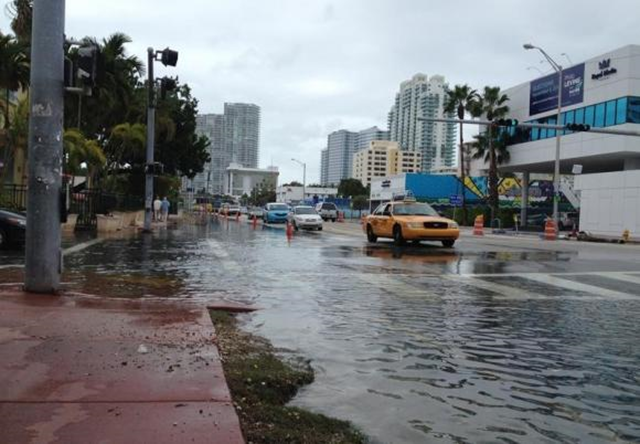U.S. coastal flooding on the rise, U.S. government study finds – ‘The effects of rising sea levels are only going to become more noticeable and much more severe in the coming decades’
By Ryan McNeill; editing by John Blanton
28 July 2014 (Reuters) – Flooding is increasing in frequency along much of the U.S. coast, and the rate of increase is accelerating along the Gulf of Mexico and Atlantic coasts, a team of federal government scientists found in a study released Monday. The study examined how often 45 tide gauges along the country’s shore exceeded National Weather Service flood thresholds across several decades. The researchers found that the frequency of flooding increased at 41 locations. Moreover, they found that the rate of increase was accelerating at 28 of those locations. The highest rates of increase were concentrated along the mid-Atlantic coast. “We stress that in many areas, the frequency of nuisance flooding is already on an accelerating trajectory, and many other locations will soon follow” if trends in rising sea levels continue, the scientists wrote. The thresholds are usually associated with minor flooding, also called nuisance flooding, which can overwhelm drainage systems, cause road closures and damage infrastructure not built to withstand frequent flooding or exposure to salt water. Such flooding is one of the more recognizable effects of rising seas, as opposed to less frequent but more damaging extreme storms, such as hurricanes, the scientists said. In the 1950s, nuisance flooding occurred once every one to five years, the study found. By 2012, the frequency had increased to about once every three months at most NOAA gauges. These storms “are no longer really extreme,” said William Sweet, a NOAA oceanographer and lead author of the study. “It takes a lesser storm to inundate similar (elevations).” The study is the latest to examine whether minor flooding is increasing as seas rise. Reuters published the results of its own independent analysis earlier this month that found that the number of days a year that tidal waters reached or exceeded flood thresholds more than tripled in many places. Another study, by Old Dominion University researchers Tal Ezer and Larry Atkinson, found that the U.S. East Coast is “a hotspot of accelerated flooding.” They also found that flooding outside of storm events has increased in frequency and duration. The results of their study are expected to be published later this year. [more]
U.S. coastal flooding on the rise, government study finds 
28 July 2014 (NOAA) – Eight of the top 10 U.S. cities that have seen an increase in so-called “nuisance flooding”–which causes such public inconveniences as frequent road closures, overwhelmed storm drains and compromised infrastructure–are on the East Coast, according to a new NOAA technical report. This nuisance flooding, caused by rising sea levels, has increased on all three U.S. coasts, between 300 and 925 percent since the 1960s. The report, Sea Level Rise and Nuisance Flood Frequency Changes around the United States, also finds Annapolis and Baltimore, Maryland, lead the list with an increase in number of flood days of more than 920 percent since 1960. Port Isabel, Texas, along the Gulf coast, showed an increase of 547 percent, and nuisance flood days in San Francisco, California increased 364 percent. “Achieving resilience requires understanding environmental threats and vulnerabilities to combat issues like sea level rise,” says Holly Bamford, Ph.D., NOAA assistant administrator of the National Ocean Service. “The nuisance flood study provides the kind of actionable environmental intelligence that can guide coastal resilience efforts.” “As relative sea level increases, it no longer takes a strong storm or a hurricane to cause flooding,” said William Sweet, Ph.D., oceanographer at NOAA’s Center for Operational Oceanographic Products and Services (CO-OPS) and the report’s lead author. “Flooding now occurs with high tides in many locations due to climate-related sea level rise, land subsidence, and the loss of natural barriers. The effects of rising sea levels along most of the continental U.S. coastline are only going to become more noticeable and much more severe in the coming decades, probably more so than any other climate-change related factor.” The study was conducted by scientists at CO-OPS, who looked at data from 45 NOAA water level gauges with long data records around the country and compared that to reports of number of days of nuisance floods. The extent of nuisance flooding depends on multiple factors, including topography and land cover. The study defines nuisance flooding as a daily rise in water level above the minor flooding threshold set locally by NOAA’s National Weather Service, and focused on coastal areas at or below these levels that are especially susceptible to flooding. The report concludes that any acceleration in sea level rise that is predicted to occur this century will further intensify nuisance flooding impacts over time, and will further reduce the time between flood events. The report provides critical NOAA environmental data that can help coastal communities assess flooding risk, develop ways to mitigate and adapt to the effects of sea level rise, and improve coastal resiliency in the face of climate- and weather-induced changes. NOAA’s mission is to understand and predict changes in the Earth’s environment, from the depths of the ocean to the surface of the sun, and to conserve and manage our coastal and marine resources. Join us on Twitter, Facebook and our other social media channels.
NOAA: ‘Nuisance flooding’ an increasing problem as coastal sea levels rise
